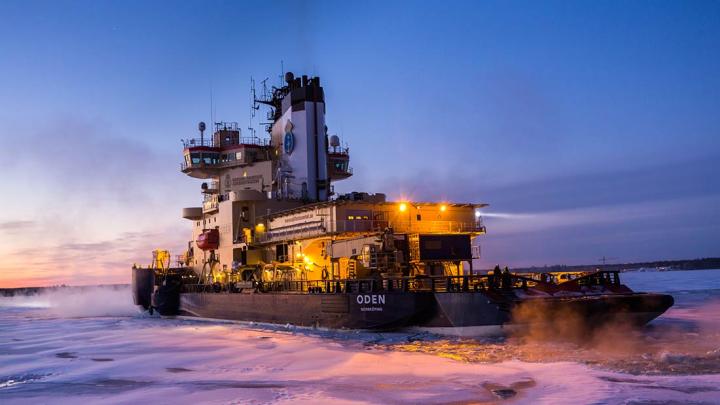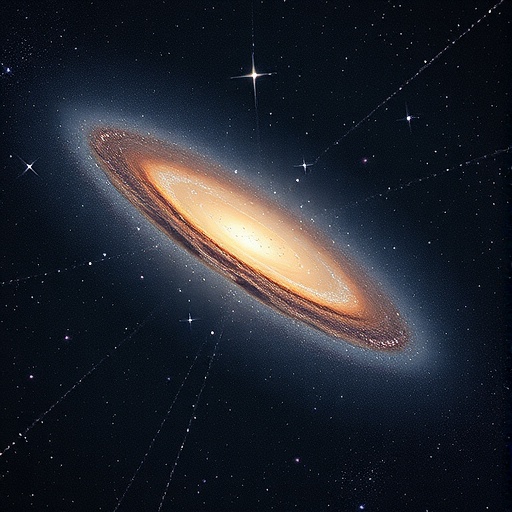On an 18-day voyage July 18 — August 4, 2019 US/Canadian team of experts and students to measure vital signs of polar ocean environment, offer real time reports

Credit: Lars Lehnert
A team of natural and social scientists, supported by 25 post-secondary students from the U.S. and Canada, will study vital signs of a rapidly changing Arctic Ocean this summer, and offer the public a chance to share the experience in real time.
The innovative, 18-day Northwest Passage Project research expedition will depart on July 18 from the U.S. Air Base in Thule, Greenland, aboard the Swedish Icebreaker Oden, returning to Thule August 4 after a 2,000 nautical mile voyage through the Northwest Passage (itinerary below)
On the Oden, operated by the Swedish Polar Research Secretariat (SPRS, https:/
Led by the University of Rhode Island’s Inner Space Center (ISC), with major funding from the U.S. National Science Foundation and additional support from the Heising-Simons Foundation, the expedition will include the first-ever live, interactive broadcasts from the Northwest Passage.
Public audiences will have unprecedented ways to interact with the expedition’s shipboard participants in real time, including Facebook Live broadcasts from sea and special events with three prestigious science centers: the Smithsonian National Museum of Natural History, Washington DC, the Exploratorium, San Francisco CA, and the Alaska SeaLife Center, Seward AK.
Details of the project’s public events: http://bit.
“It is important for people everywhere on Earth to see and understand how this region affects all of us,” says NPP principal investigator and project director Gail Scowcroft. “The region’s meltwater, water circulation, and exchange of greenhouse gases between the ocean and the atmosphere are causing wide-scale environmental and climatic changes, which increasingly affect people and wildlife diversity around the world.”
In addition to the many live interactions while at sea, the project will also be the subject of a two-hour television documentary in 2020, Frozen Obsession, being produced and directed by Emmy Award-winning director David Clark.
Research to aid understanding of / document climate change effects
Using a suite of instruments, the project will help fill significant gaps in critical scientific data about the region, a welcome addition of knowledge in an age of rare and extremely costly Arctic research, as noted by ScienceMagazine in an article last year.
The expedition’s chief scientist, Dr. Brice Loose of the University of Rhode Island Graduate School of Oceanography, is coordinating and leading the research into the exchange of greenhouse gases between the water and atmosphere, and changes in distribution and abundance of two vulnerable levels of the Arctic food web – plankton and seabirds.
Scientific research areas
Water mass properties and circulation inside the Canadian Arctic Archipelago (CAA)
The project will investigate the increased freshwater storage in and export from the upper Arctic Ocean due to a warming Arctic.
Increased melting, river discharge, as well as changing wind patterns have led to increased freshwater accumulation in the western Arctic. The CAA, and particularly the Northwest Passage, is one of the principle conduits for freshwater transport from the Arctic Ocean to the North Atlantic, however, there are uncertainties in the magnitude of transport and water properties.
Donglai Gong of the Virginia Institute of Marine Science will deploy a suite of high-tech instruments to measure water column temperature, salinity, dissolved oxygen, fluorescence, and optical backscattering (reflection), providing a high-resolution view of currents, water masses, and biology.
Chemistry of the melting Arctic and marginal seas: Water column chemistry affecting greenhouse gas fluxes
The concentration and isotopic composition of methane and carbon dioxide in the Arctic Ocean and atmosphere are of great interest, as both are greenhouse gases and the sources and flux of both between the ocean and atmosphere are important components of the global climate system.
The Arctic Ocean generally absorbs carbon dioxide, but ice cover limits air-sea exchange. Measuring carbon dioxide and its isotopic composition can provide information about the carbon system’s sources and fluxes into the atmosphere. Methane, a more potent greenhouse gas than carbon dioxide, is found throughout the Arctic Circle, and the Arctic appears to be an ever-growing source of methane to the atmosphere. Methane is found in land-based permafrost and is also distributed along the seafloor as methane ice or methane hydrates.
With less sea ice cover, there can be an increased flux of methane into the atmosphere from the ocean. However, some microbes in ocean water use methane as a food source. If microbial breakdown of methane is rapid enough, it may serve to offset the methane that escapes to the atmosphere. There is little data to provide estimates of this methane breakdown in Arctic water. Dr. Loose’s research will study this microbial breakdown of methane and the rate at which it occurs in the Northwest Passage region.
Ecosystem surveys of Arctic habitats in transition: Distribution and abundance of zooplankton and phytoplankton
As the waters of the Arctic warm and the sea ice cover decreases, the Arctic surface ocean ecosystem is anticipated to undergo considerable changes. Habitats are changing and moving, perhaps disappearing, and species distribution and abundance also may be changing rapidly.
To observe phytoplankton and zooplankton, the Northwest Passage Project will periodically conduct plankton-net tows in the upper water column (100m and less). The contents of the nets will be catalogued. The organisms collected in these net tows will be counted with a laboratory bench-top Flowcam.
The Flowcam counts and images micrometer size particles using an imaging microscope. This provides the ability to identify and quantify ‘particles’ from some sampled volume. These particles can be sediments, phytoplankton, or even zooplankton. This imaging system will generate a library of images for each transect and store them for later investigation.
Arctic habitats in transition: Distributions of Marine Birds in Canadian Arctic Waters
Marine bird abundance and distribution can be used to monitor changes and variability in marine ecosystems. NPP participants will characterize the distribution and abundance of marine birds along the survey route. Associations between the marine bird community and the physical and biological properties of their marine environment will be identified and compared to past results. The expedition will use a standard non-invasive, observational method to perform seabird counts.
NW Passage geopolitics, and how climate change affects indigenous populations
The project will also contribute to understanding of the maritime history of the Northwest Passage, the role of the Inuit people in Arctic history, the effects of climate change on indigenous populations, and the geopolitics of a waterway confronted with threats from resource extraction, increased shipping commerce, and pollution.
NPP Itinerary
July 17: Depart Thule, Greenland
July 20: Arrive Pond Inlet, Canada
July 21: Depart Pond Inlet, Sail through Lancaster Sound to Barrow Strait
July 26: Arrive Resolute
July 26: Sail west to Melville Sound
July 29: Sail east to Barrow Strait
July 31: Sail south into Prince Regent Sound
August 4: Arrive Thule, Greenland
Engaging youth, early career scientists, and the public
The team of scientists and students represent the following institutions:
- University of Rhode Island Graduate School of Oceanography
- City College of New York
- Pennsylvania State University
- California State University Channel Islands
- Florida International University, Miami
- Virginia Commonwealth University
- University of Illinois Chicago
- Virginia Institute of Marine Sciences
- Royal Canadian Geographic Society
URI Inner Space Center’s advanced telepresence technology
Live interactive broadcasts throughout the expedition will use the ISC’s advanced telepresence technology and video production facility. Pre-expedition webinars, archived online, will prepare the students for their research experiences.
The ISC will also produce daily video blasts using footage supplied by the onboard filmmakers. These video blasts will be used during broadcasts and live interactions with partner sites. They will also be available on the ISC’s YouTube channel.
The ISC will receive a live satellite link from the ship and connect it to the partner sites, allowing audiences to communicate with the shipboard scientists and students. The pre-produced video segments will be made available to the partner institutions for use in their other educational activities, and will also be made available on the project website.
Since the Arctic is an extreme environment and at any time during the expedition may experience weather that disrupts the satellite signal, these highlight videos will allow the ISC to conduct an interactive program with the partner institutions without the live interaction from sea, if necessary.
Frozen Obsession: A two-hour television documentary by Emmy-winning director David Clark
Emmy Award-winning director David Clark will produce and direct a two-hour television documentary, Frozen Obsession, which will explore the changing Arctic by documenting the NPP expedition. The film will highlight the expedition’s research and document the activities of the diverse group of participants (scientists, historians, journalists, educators, and students) and their various experiences.
The documentary will also explore the maritime history of the Northwest Passage, the role of the indigenous Inuit people in the Arctic’s history and changes affecting their way of life, and the geopolitics of this Arctic waterway (more information: http://www.
Special screening events will take place at each of the NPP partner institutions, at Penn State’s Polar Center, and at the Environmental Film Festival. The film will have a television broadcast and also be available for future theatrical distribution. The program will be combined with online/social media, community outreach, and youth activities. The project’s participants will host screenings of the documentary in their schools and institutions.
Award-winning author and journalist Ed Struzik, who has written about the Arctic for three decades, will be onboard to share his perspective on critical wildlife issues, the native Inuit culture, impacts of climate change, and prospects of Arctic resource extraction and commercial shipping traffic in the Passage.
###
Project Partners:
Lead Institution: University of Rhode Island: http://www.
Graduate School of Oceanography: web.uri.edu/gso
Inner Space Center: web.uri.edu/gso/inner-space-center
David Clark Inc. http://www.
U.S. Minority Serving Institutions:
- California State University Channel Islands: http://www.
csuci. edu - City College of New York: http://www.
ccny. cuny. edu - Florida International University: http://www.
fiu. edu - Virginia Commonwealth University: http://www.
vcu. edu - University of Illinois Chicago: http://www.
uic. edu
Museum partners
- Alaska SeaLife Center: http://www.
alaskasealife. org Exploratorium: http://www.
exploratorium. edu Smithsonian Institution National Museum of Natural History: https:/
/ naturalhistory. si. edu
Research partners
- Virginia Institute of Marine Science / William & Mary: http://www.
vims. edu - Canadian Wildlife Service, Environment and Climate Change Canada: https:/
/ www. canada. ca/ en/ environment-climate-change. html - Swedish Polar Research Secretariat
- Climate Change Education Partnership Alliance: http://ccepalliance.
org - Consortium for Ocean Science Exploration and Engagement: http://www.
cosee. net/ about/ consortium - Penn State: http://www.
psu. edu - People, Places, and Design Research: http://ppdresearch.
com - Interface Guru: https:/
/ www. interfaceguru. com
About the Project’s Funders
National Science Foundation
The National Science Foundation (NSF) is an independent federal agency that supports fundamental research and education across all fields of science and engineering. In fiscal year (FY) 2019, its budget is $8.1 billion. NSF funds reach all 50 states through grants to nearly 2,000 colleges, universities and other institutions. Each year, NSF receives more than 50,000 competitive proposals for funding and makes about 12,000 new funding awards.
Heising-Simons Foundation
The Heising-Simons Foundation is a family foundation based in Los Altos and San Francisco, California. The Foundation works with its many partners to advance sustainable solutions in climate and clean energy, enable groundbreaking research in science, enhance the education of our youngest learners, and support human rights for all people.
Media Contact
Terry Collins
[email protected]




